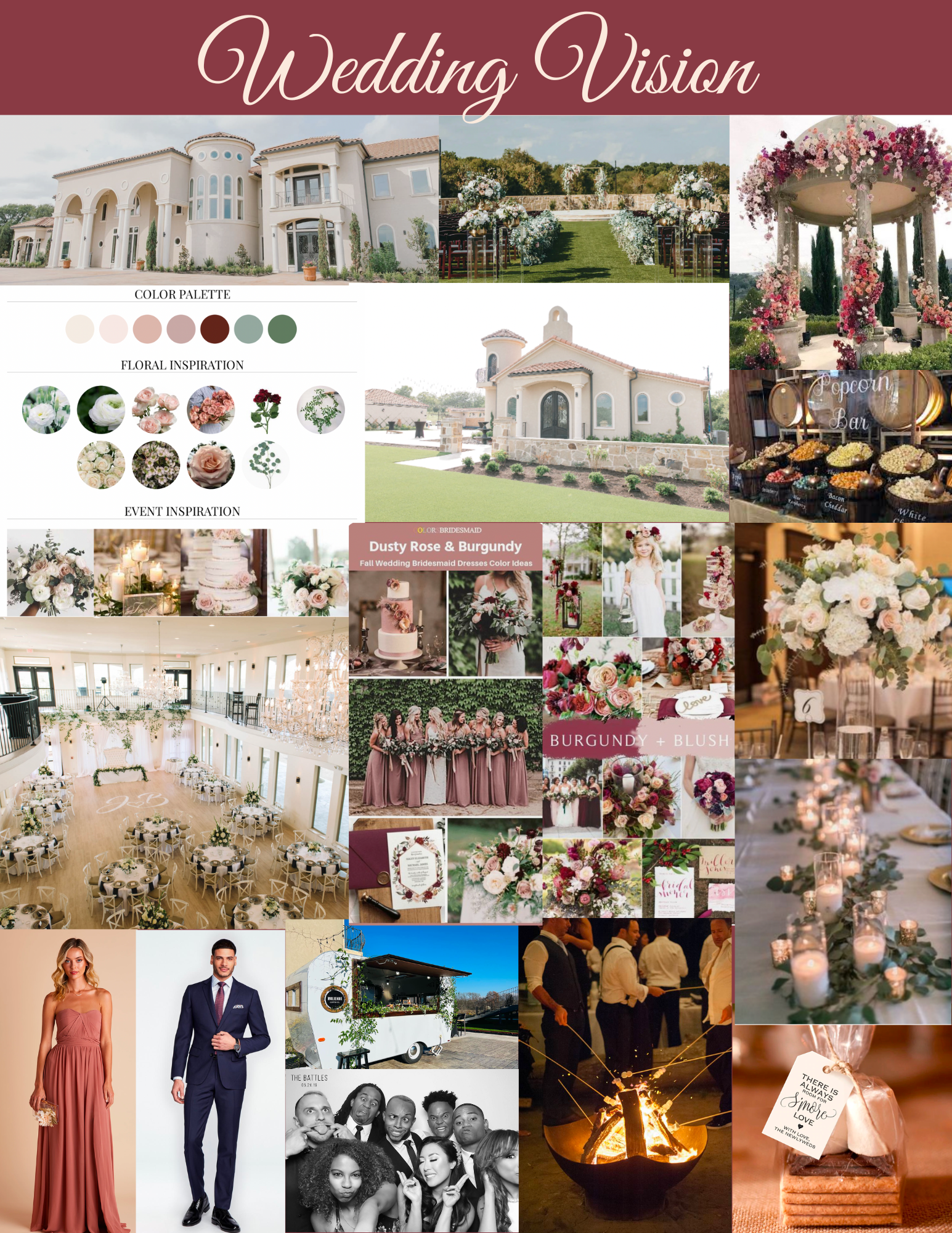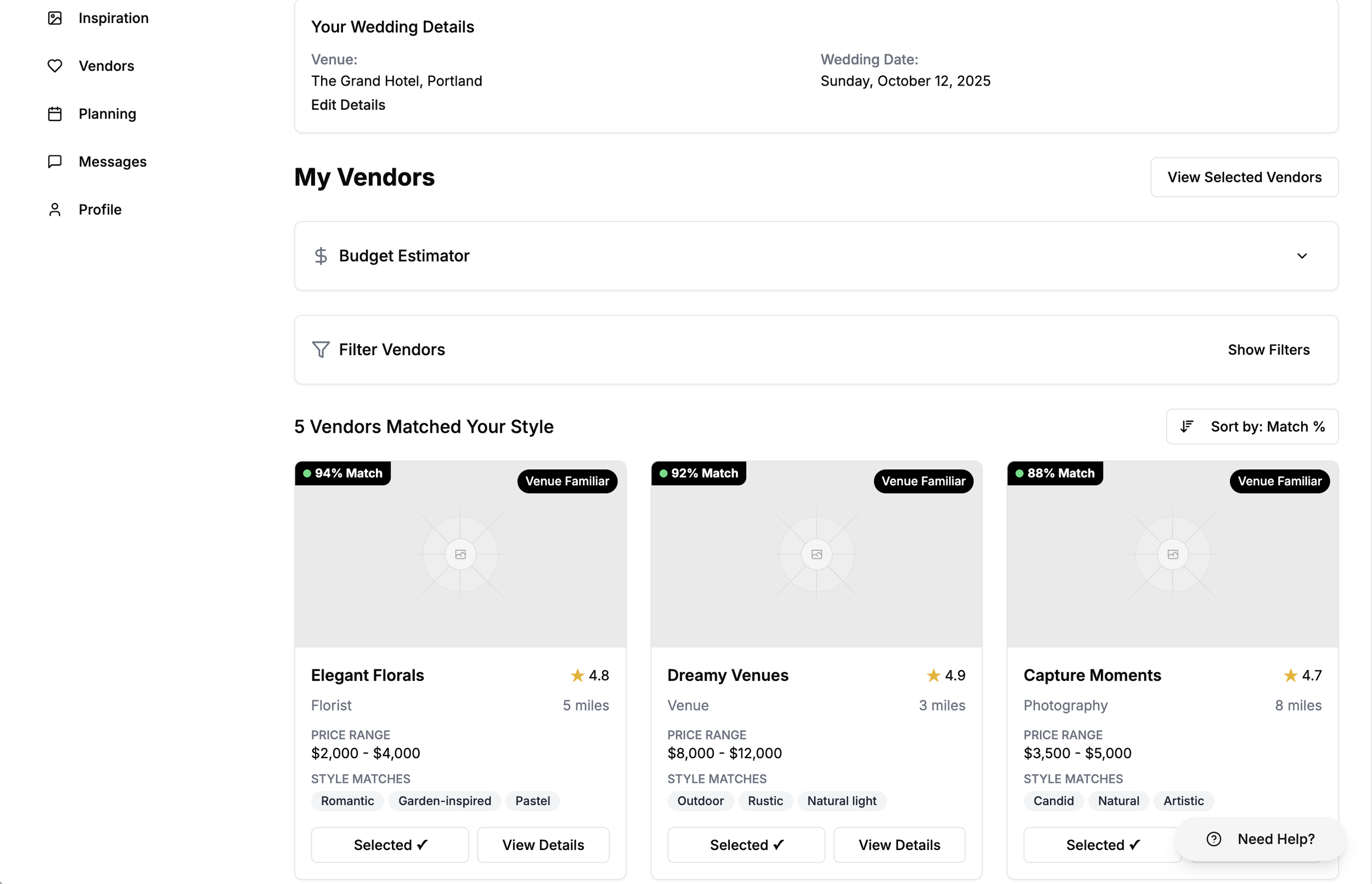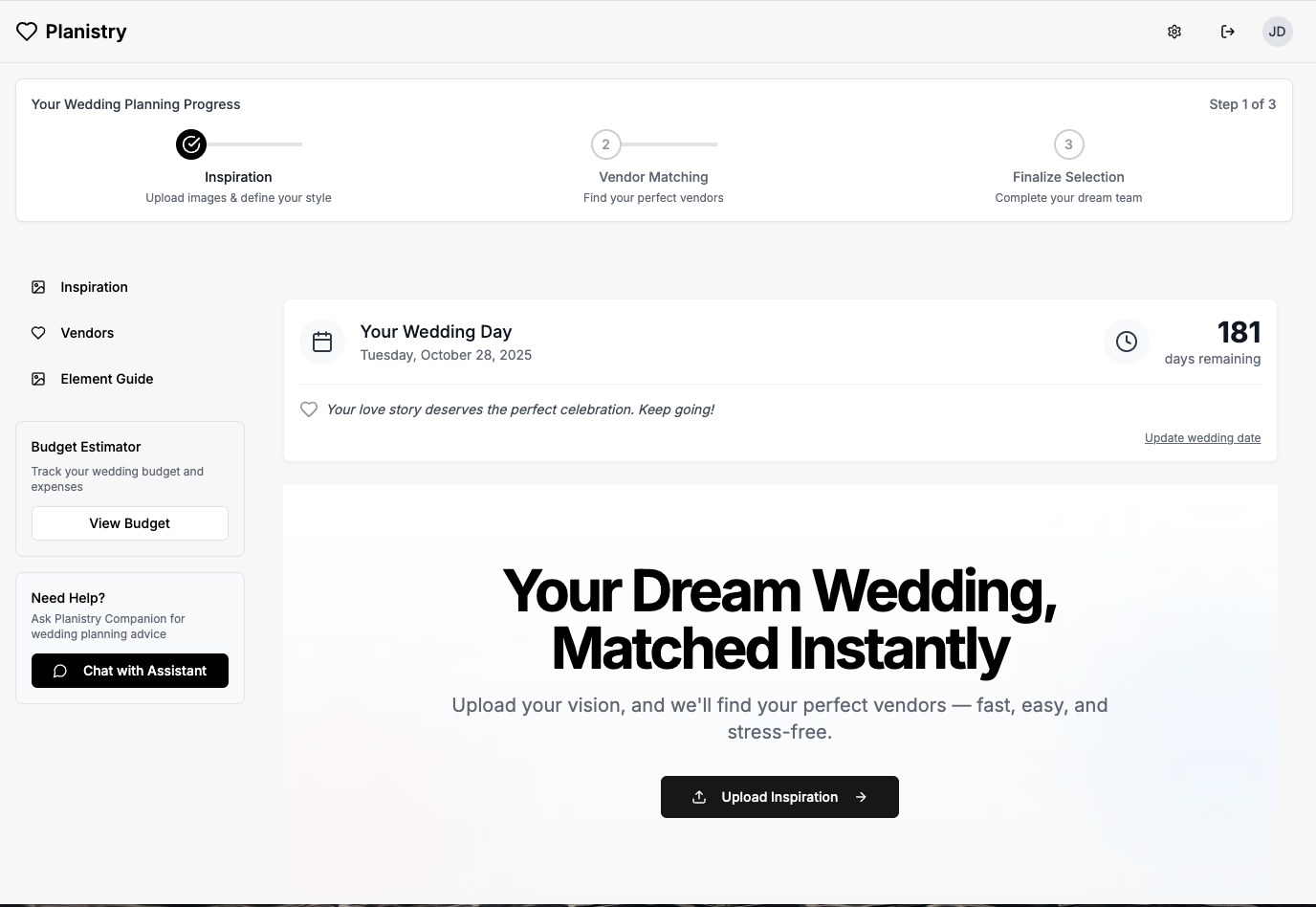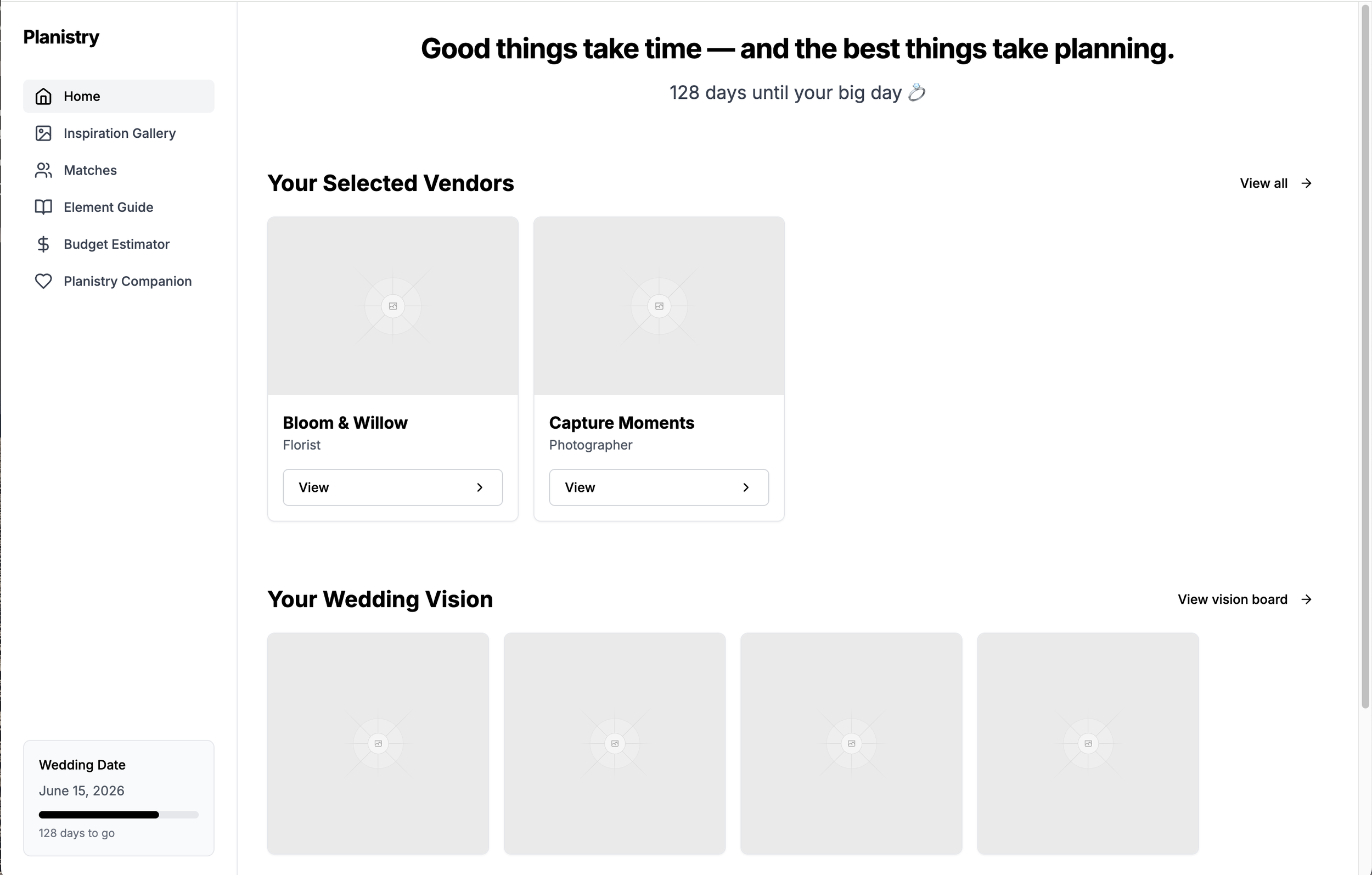
Overview
Planning a wedding should feel exciting, not like navigating a maze of spreadsheets, guesswork, and endless decisions. With Planistry, I created a solution where couples can simply upload their inspiration images and get matched with vendors who match their style, location, and vision. I led the design from early research through prototyping, always centering the experience around real couples’ needs. Along the way, I surfaced opportunities to extend value on both sides of the marketplace—helping vendors reach better-fit clients with less effort, and opening doors for future monetization.
Couples often start with a clear vision of what they want their wedding to look like, usually inspired by Pinterest boards or Instagram posts. However, translating those ideas into concrete vendor decisions can be overwhelming. Existing tools lack personalization, leading to decision fatigue and uncertainty.
Problem
By focusing on the couple’s inspiration images as a starting point, I saw the opportunity to reimagine vendor discovery as a visual-first, AI-powered experience. Planistry takes their style and translates it into tailored, local vendor matches, reducing friction and helping couples move confidently from vision to vendor.
Opportunity
The vision board I used to plan my October 2022 wedding, the inspiration behind Planistry
User & Market Insights
Planning my own wedding showed me just how overwhelming the vendor search process can be! To see if other couples shared the same frustration, I spoke with recently engaged couples and newlyweds. I also explored popular planning tools like The Knot and Zola to better understand how the market currently handles vendor discovery.
What I Heard from Couples:
Most had inspiration (like Pinterest boards or saved Instagram posts) but weren’t sure how to turn those ideas into actual vendor choices.
They felt overwhelmed by the sheer number of options and weren’t sure how to find the right fit.
Many didn’t fully understand the different types of vendors or even where to begin, especially for less common categories.
The whole process felt manual, impersonal, and exhausting.
+
What I Saw in the Market:
Leading platforms rely on static directories with tons of filters, making users do all the heavy lifting when it comes to comparison.
There’s no connection between saved inspiration and the vendor recommendations users receive.
Personalization is limited to location and budget—nothing about style or vision.
These combined insights revealed a clear opportunity: shift the vendor search from a manual, filter-heavy task to an intuitive, image-driven journey, bridging the gap between inspiration and action.
Product Vision & AI Integration
Planistry transforms the vendor discovery process into a visual-first, AI-powered experience. Couples simply upload their inspiration images and are matched with local vendors who align with their style and vision, making the journey from concept to decision effortless.
Behind the scenes, Planistry’s AI dives deep into each image, identifying style, color palette, and key elements like florals or décor. It then cross-references these with vendor portfolios based on location, budget, and availability. Couples can even tag their favorite elements, refining the AI’s recommendations for a more personalized match. A clean, focused interface, transparent vendor profiles, and intuitive filters work seamlessly together to reduce friction, build trust, and deliver tailored, actionable results in minutes
Key Features:
AI-Powered Vendor Matching: Planistry uses inspiration images to match couples with vendors that fit their style, budget, and location.
Smarter Results with Tagging: Couples can highlight what they love in each image to refine recommendations.
Clear, Detailed Vendor Profiles: Every match includes photos, services, reviews, and availability, no surprises.
Fast, Frictionless Experience: From upload to match in minutes, with a clean, easy-to-use interface.
Curious how the AI works behind the scenes? Check out the technical deep dive: Planistry: How It Works.
Initial design: Featuring AI-powered matching, smart tagging, and detailed profiles for a seamless experience.
Learning Through Iteration
I started fast, using tools like ChatGPT and v0.dev to spin up early flows and wireframes around key features like image uploads and vendor matching. The speed was exciting, but in letting AI lead without clear requirements, I ended up with a cluttered interface and a disconnected user journey.
Early concept misstep: A cluttered, AI-generated flow that lacked clarity and cohesion.
So I stepped back, clarified the experience I was aiming for, and re-grounded the design in real user needs. With stronger prompts and tighter direction, I returned to the tools and rebuilt a more focused prototype, one that felt intuitive, purposeful, and aligned with the people it was designed for.
Usability testing brought even more clarity, surfacing feedback that shaped the final flow and reinforced a simple truth: AI is a great co-pilot, but human insight drives great design.
Refined and grounded: A cleaner, more focused interface shaped by real user needs and clearer design intent.
User Testing Insights
User testing revealed that couples weren’t just looking for matches—they wanted more support, flexibility, and confidence as they planned. I organized the feedback into three core needs and iterated directly on the prototype to meet them:
More Guidance - “This could replace an actual planner, if it guided me more.”
→ I added a friendly planning assistant that breaks down next steps, answers questions, and offers encouraging nudges along the way.Flexible Starting Points - “What if I don’t have images yet?”
→ To lower the barrier to entry, I introduced a curated gallery of inspiration. Couples can now explore and select sample images to jumpstart their journey, even without uploading their own.Trust in Vendor Fit - “I trust vendors who’ve worked at my venue.”
→ I added venue-based filters that highlight vendors with direct experience at the couple’s chosen location, boosting both relevance and peace of mind.
These updates helped shift Planistry from a matching tool to a supportive planning partner, meeting couples where they are, and guiding them with clarity and care.
Bringing It All Together
Planistry is designed to feel like a smart, supportive planning partner. Couples can upload their own inspiration images or choose from a curated gallery to kick off the vendor matching process. The AI analyzes each image for style, color, and key elements, then recommends local vendors whose work aligns with that vision.
Couples can tag what they love to improve match quality, while venue-based filters surface vendors with relevant experience. A built-in planning assistant provides helpful prompts and guidance throughout, breaking big decisions into smaller, confidence-boosting steps and keeping the experience clear, personal, and stress-free.
Explore the interactive prototype on v0.dev (best viewed on desktop).
Walkthrough: Vision to Vendor - See how Planistry turns inspiration into confident, personalized vendor matches.
Outcomes & What’s Ahead
Planistry’s early testing shows strong traction. Couples connected with the visual-first experience, and personalized vendor matches made planning feel less overwhelming. Key design choices, like curated image galleries and chat guidance, helped reduce friction and build trust.
What I Learned:
Couples want clarity and confidence. Personalized matches, transparent profiles, and timely guidance drove engagement.
Small changes made a big impact. Venue-based filters and the ability to start without images gave users more flexibility.
What’s Next:
Deepen the feedback loop to refine the experience and better meet user needs.
Grow the vendor ecosystem, focusing on niche categories for more variety.
Scale with intention, optimizing for fast, reliable growth.
Explore monetization thoughtfully through models like premium features, lead generation and partnerships & advertising.
Planistry started with a vision to make wedding planning more intuitive for couples, but there's just as much opportunity to empower vendors by helping them connect with the right clients, more efficiently and meaningfully.
Product Roadmap
This product roadmap outlines a potential path for Planistry's growth, dependent on aligning resources and gaining more insights from both users and technical feasibility. It highlights key steps to refine the experience and expand features, while remaining adaptable to ensure the product evolves in the most impactful way.
Q2:
Backend Development: Finalize the infrastructure for vendor data and refine the matching algorithms.
Pilot Testing: Run user experience tests using simulated data across two metro areas to gather early insights.
Vendor Experience Design: Begin building the initial vendor profile creation and management tools.
Q3:
Vendor Onboarding & Beta Monetization: Start expanding vendor profiles and testing potential monetization strategies with a small group of vendors.
Refine Vendor Experience: Iterate on feedback to improve vendor profile features and ensure a smooth experience.
Q4:
Expand AI Capabilities: Enhance AI image recognition and matching accuracy to better connect couples with vendors.
Finalize Vendor Experience: Launch a vendor dashboard with analytics and booking management tools to help vendors track performance and manage client relationships.
Conclusion
Through my work on Planistry, I gained valuable insights into how AI can be used to drive product design. While I didn’t directly work with the AI powering Planistry, I collaborated with tools like ChatGPT and v0.dev to design the initial prototype. This experience highlighted the potential of AI to accelerate the design process, but also reinforced the importance of defining clear user goals to guide AI’s application.
I learned that working with AI, especially when designing for AI-powered products, requires a careful balance between leveraging its capabilities and maintaining a clear, user-centered design. The theoretical understanding I’ve developed, like the use of vector space and cosine similarity for vendor matching, has deepened my appreciation for how AI can enhance the user experience through smarter, more personalized recommendations. (For a closer look at the system architecture and AI logic, head to Planistry: How It Works.)
In the future, I’d look forward to gaining hands-on experience with these AI algorithms, understanding their integration in real-time systems, and refining AI outputs based on user feedback. This project solidified my passion for creating intuitive, AI-driven products, and I’m eager to continue working at the intersection of design, technology, and user needs.



